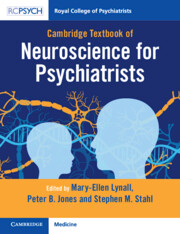Book contents
- Cambridge Textbook Of Neuroscience for Psychiatrists
- Reviews
- Cambridge Textbook of Neuroscience for Psychiatrists
- Copyright page
- Contents
- Contributors
- Introduction
- 1 Cells
- 2 Neurotransmitters and Receptors
- 3 Basic Techniques in Neuroscience
- 4 Neuroanatomy
- 5 Neural Circuits
- 5.1 Appetite
- 5.2 Sleep
- 5.3 Sex and Sex Hormones
- 5.4 Violence and Aggression
- 5.5 Nociception and Pain
- 5.6 The Motor System and Movement Disorders
- 5.7 Computational Models of Learning
- 5.8 Habit Formation
- 5.9 Reward, Pleasure and Motivation
- 5.10 Emotion
- 5.11 Perception
- 5.12 Attention
- 5.13 Apathy, Anhedonia and Fatigue
- 5.14 Memory
- 5.15 Fronto-Executive Functions
- 5.16 Empathy and Theory of Mind
- 5.17 Language
- 5.18 Brain Networks and Dysconnectivity
- 6 Modulators
- 7 Genetics
- 8 Neurodevelopment and Neuroplasticity
- 9 Integrated Neurobiology of Specific Syndromes and Treatments
- 10 Neurodegeneration
- Index
- References
5.15 - Fronto-Executive Functions
from 5 - Neural Circuits
Published online by Cambridge University Press: 08 November 2023
- Cambridge Textbook Of Neuroscience for Psychiatrists
- Reviews
- Cambridge Textbook of Neuroscience for Psychiatrists
- Copyright page
- Contents
- Contributors
- Introduction
- 1 Cells
- 2 Neurotransmitters and Receptors
- 3 Basic Techniques in Neuroscience
- 4 Neuroanatomy
- 5 Neural Circuits
- 5.1 Appetite
- 5.2 Sleep
- 5.3 Sex and Sex Hormones
- 5.4 Violence and Aggression
- 5.5 Nociception and Pain
- 5.6 The Motor System and Movement Disorders
- 5.7 Computational Models of Learning
- 5.8 Habit Formation
- 5.9 Reward, Pleasure and Motivation
- 5.10 Emotion
- 5.11 Perception
- 5.12 Attention
- 5.13 Apathy, Anhedonia and Fatigue
- 5.14 Memory
- 5.15 Fronto-Executive Functions
- 5.16 Empathy and Theory of Mind
- 5.17 Language
- 5.18 Brain Networks and Dysconnectivity
- 6 Modulators
- 7 Genetics
- 8 Neurodevelopment and Neuroplasticity
- 9 Integrated Neurobiology of Specific Syndromes and Treatments
- 10 Neurodegeneration
- Index
- References
Summary
The frontal lobes of the brain have often been associated with rather vague conclusions about their functions in both the healthy and diseased brain. However, recent research that utilises neuropsychological assessment of patients as well as functional neuroimaging in humans, and experimental studies of other mammalian species, has begun to elucidate their roles in what has been termed ‘executive function’ or ‘cognitive control’. They have evolved in humans to occupy about a third of the entire cerebral cortex and are reciprocally connected to much of the rest of the brain. Their importance to psychiatry is that they have been implicated in virtually all forms of psychiatric disorder. The exact nature of their contribution to specific symptoms, however, is still to be determined.
- Type
- Chapter
- Information
- Cambridge Textbook of Neuroscience for Psychiatrists , pp. 253 - 262Publisher: Cambridge University PressPrint publication year: 2023

